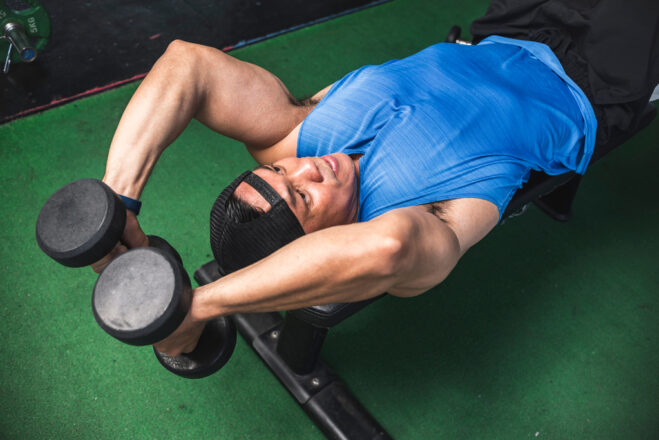Skull crushers may sound daunting. They are one of the most intense arm exercises you can do. But if you get the form right and start slow, you can crush your way to bigger, more powerful triceps.
So, what are skull crushers exactly? Skull crushers are one of the best exercises for working the tricep muscles at the back of your upper arms.
You need a pair of dumbbells or a barbell for this exercise, which you do while lying on the floor or on a bench press. During the exercise, you bring the dumbbells from an overhead position toward your skull.
The name “skull crushers” comes from what can happen if you don’t do the exercise correctly. A more friendly name for it that better explains its mechanics is lying tricep extensions.
So, what muscles do skull crushers work exactly? Read on to find out and discover their benefits and how to do skull crushers the right way.
In This Article:
Benefits of Skull Crushers
When done correctly, the skull crushers exercise isolates your tricep muscles and gives them a powerful workout. Let’s take a closer look at some of the key advantages of the exercise.
- Add mass to your triceps. By activating the medial head of the triceps, skull crushers can help you bulk up your triceps. It can be a good exercise if you want stronger, more defined upper arms.
- Address tricep imbalances. When one tricep is stronger than the other, the result can be uneven muscle gain. This can happen if you do exercises that won’t stretch all the heads of the triceps on both arms. You can use skull crushers to correct imbalances in your tricep muscles.
- Improve elbow health. Stronger triceps can better absorb loads. This eases the strain on the tendons and joints. It can reduce the risk of an elbow injury during training and everyday activities.
- Improve throwing power. Throwing the ball relies on the extension or straightening of the elbow. A skull crusher workout can help you make more powerful throws.
- Make everyday movements easier. Tricep exercises like skull crushers make push and pull movements easier. It helps with pushing a wheelbarrow loaded with compost or moving furniture.
Muscles Worked by Skull Crushers
So, what do skull crushers work exactly? A push exercise, skull crushers work the triceps from the elbow to the lats, the broadest muscles of the back. The triceps brachii is a muscle group located at the back of your upper arm. It straightens your elbow and helps extend your shoulder.
The medial and lateral heads of the muscle connect the back of the upper humerus bone in the arm to the back of the elbow. The long head, meanwhile, connects the humerus to the shoulder joint.
What about other muscles? What do skull crushers work apart from the triceps? To a lesser extent, skull crushers also work the rear deltoid and scapular stabilizers. These muscles keep the shoulder socket stable during the exercise.
How to Do Skull Crushers
Doing standard skull crushers doesn’t have to be crushingly hard. Grab a pair of dumbbells and, optionally, a floor mat. Start with a comfortable weight. You can increase the load as you become used to the exercise. Don’t put too much load on your triceps, or you’ll risk injury.
The easiest way to get started is to use an easy bar without added weights. Here’s how to do skull crushers safely and correctly for beginners:
- Lie on the floor mat with your knees up and the dumbbells on either side of you. Your feet should be flat on the floor and your spine neutral.
- Grip the easy bar with your palms facing down. Keep your hands at shoulder-width.
- Extend your arms and press the bar toward the ceiling.
- Flex your elbows to lower the bar with a slow and controlled movement until it reaches behind your ears. Your upper arms shouldn’t be rocking, or you’ll load the shoulders.
- Straighten your arms and push the bar up to the initial position.
- Repeat 8 times per set. Do up to 3 sets. Once you build strength, you can do 12 reps per set or more.
Important: If you experience elbow pain or any other pain while doing skull crushers, stop immediately. Continuing can lead to a triceps tendon rupture or another related injury that can sideline you.
Skull Crusher Variations
Once you feel comfortable with the standard skull crushers exercise, you can try barbell skull crushers and a few other variations. Bear in mind that these are challenging. Don’t start with them if you haven’t done the basic exercise before.
Barbell skull crushers
For the first skull crusher variation on our list, you need a barbell and a flat bench.
1. Take your seat on the bench holding the barbell on your lap with a shoulder-width grip. Make sure your palms are face down.
2. Lie on your back, lifting the barbell over your collarbone.
3. Bend your elbows to bring the weight down over your head. Ensure your elbows point ahead, and your shoulders remain stable.
4. After holding for 1 second, push the barbell back to the starting position as you straighten your elbows.
5. Do 6–12 reps each for up to 3 sets.
Incline skull crushers
For incline skull crushers, set the bench at a slight incline to increase the stretch in your triceps. You can use dumbbells, a barbell, or a kettlebell.
1. Set the backrest incline to 30 degrees.
2. Sit on the bench and hold the weight with an overhand grip at shoulder width.
3. Move your upper body toward the back pad and lie back.
4. Press the weight over your forehead.
5. Bend down your elbows to lower the weight behind the bench. Go all the way down until you feel the stretch in your upper arms.
6. Straighten your elbows with a controlled movement to bring the weight back up.
7. Do 6–12 reps, up to 3 sets.
Dumbbell skull crushers
This skull crusher variant calls for two low-weight dumbbells. When doing dumbbell skull crushers, you need to maintain a balance between both sides and keep your core stable.
1. Lie on your back on the floor or bench, holding the dumbbells over your chest, arms straight and palms facing your feet.
2. Bend your elbows to lower the dumbbells toward your ears. Keep your shoulders stable.
3. Maintain for 1 second and flex your elbows, pushing the dumbbells back up.
4. Start with 8 reps and up to 3 sets.
Common Mistakes
Getting your skull crusher workout right helps you reap all the benefits of the exercise. From the first rep you do, pay attention to your form. Here are the mistakes you want to watch out for.
- Using too much weight. Whether you’re fit or only getting there, start with a low and comfortable weight to reduce stress on your elbows. Aim for a higher number of reps over using a big weight.
- Rushing the reps. As with many other strength training exercises, rushing through the exercise makes it less effective. To ensure proper skull crushers form, lower the weights slowly while maintaining control over your muscles.
- Having a loose grip. Maintain a strong grip on the weights throughout the exercise to prevent accidental slips.
- Not keeping hands at shoulder width. Skull crushers on a bench can put some serious stress on your elbow joints. To reduce this, the National Academy of Sports Medicine recommends keeping your hands shoulder-width apart.
Safety and Precautions
In addition to the skull crusher mistakes we’ve looked at, here are a few safety measures to keep in mind. It’s important to follow them.
- Don’t lower the weight toward your skull. They’re called skull crushers for a reason! Whether you’re using dumbbells or barbells, the weights should travel behind your head to avoid injury. Also, be careful when bringing the weight back up to avoid it brushing against the top of your head or sides of the face.
- Avoid the exercise if you have any elbow injury. You also want to avoid it if you are experiencing elbow pain.
- Have someone around when using barbells. Whether you do the exercise on a bench or on the floor, having a friend around poised to intervene can help prevent accidents.
- Don’t overload. This is so important it’s worth repeating. Start with low weights.
Skull Crusher Alternatives
Two great skull crusher alternatives are the close-grip bench press and the overhead triceps extension. Both can give your triceps a serious workout.
Close-grip bench press
This bench press variation narrows the grip on the barbell, which makes you tuck in your elbows. This increases the engagement your triceps get.
If you’re already familiar with the bench press, try this variation. Start in the usual bench press position but with a slightly closer grip than shoulder width.
Warning: Avoid a grip that’s too close. You risk injuring your wrists and dropping the weight.
Overhead tricep extension
For this exercise, you can use a dumbbell or kettlebell. You can do the exercise standing or sitting.
Hold the weight with both hands overhead. Bend your elbows with a controlled movement to lower the weight behind your head.
Go as far down as you can, being careful so that the weight doesn’t touch your body. Then flex your elbows slowly and bring the weight back overhead.
Good to know: According to a 2017 study, both lying and overhead dumbbell elbow extensions work the triceps similarly.
Takeaways
Before you start putting your triceps to work, here are a few key things to take with you:
- Do your first skull crushers with a light EZ bar before upgrading to dumbbells or barbells.
- Aim for higher reps with a lower weight instead of going straight for a heavy weight.
- Maintain proper skull crushers form throughout the exercise to avoid injury.
- Don’t do skull crushers if you have elbow problems.
- Whatever weight you use, avoid holding it over your face and rushing the exercise.
- Maintain a firm grip throughout the exercise.
Now that you know how to do skull crushers safely and with proper form, go ahead and enjoy the nice tricep stretch they’ll give you. Your triceps will love it!
References:
- Dục, G., Chính, T., Tế, K., Toán, K. and Khoán, C., Best Lateral Head Triceps Exercises (1.4 x Greater Triceps Growth!) by admin| Lượt xem: 40.
- Kompf, J., Whiteley, J., Wright, J., Brenner, P. and Camhi, S., 2023. Resistance Training Behavior Is Enhanced With Digital Behavior Change Coaching: A Randomized Controlled Trial With Novice Adults. Journal of Physical Activity and Health, 1(aop), pp.1-7.
- Bartolomei, S., Nigro, F., Lanzoni, I.M., Masina, F., Di Michele, R. and Hoffman, J.R., 2021. A comparison between total body and split routine resistance training programs in trained men. The Journal of Strength & Conditioning Research, 35(6), pp.1520-1526.
- Malpe, R., The Beginner’s Guide to Building Lean Muscle in 4 Weeks.
- Work, W.S.E.H.T., Workout Splits Explained—How They Work and Why You Need Them.
- Colucci, C., Learn How to Build Strength with Three Key Principles.














